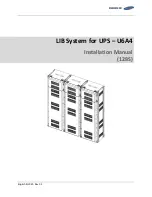
Installation
Chloride Linear Plus Series Rack-mount UPS User Instruction Manual
12
extension is connected to the battery connection the UPS (9), each subsequent extension is connected by
means of the battery extension connection cables (16). The cables are designed to be
non-interchangeable, because the sockets (13) are coded.
Connecting Mains
Connect the mains supply to the input terminals of the UPS (see Fig. 5 on page 11 and Table 6 on page 9).
Connecting parallel UPS configurations: refer to chapter “Paralleling UPS Devices” on page 19.
Connecting Load
Cables
1. Open UPS input breaker.
2. Remove terminal area safety cover.
3. Connect loads to “Output” terminals (see Fig. 5 on page 11 and Table 6 on page 9).
4. Connect mains to the corresponding input terminals (see Fig. 5 on page 11 and Table 6 on page 9).
Preparing single mode / parallel mode:
• If UPS is to be operated as single unit connect a 6 awg (10 mm
2
) jumper between S1 and S2.
• If UPS is to be operated as parallel unit ensure that no jumper is connected between S1 / S2.
External Battery
Connection
WARNING:
•The batteries installed in external battery cabinet may contain electrolyte. Under normal conditions the
containers are dry. A damaged battery may leak electrolyte which can be dangerous in contact with the
skin and cause irritation to the eyes. Should this happen wash the affected part with copious amounts of
water and seek immediate medical advice.
•Do not open or damage batteries. The released electrolyte is toxic.
•Voltage is always present on the battery contacts.
•Even when discharged a battery has the capacity to supply a high short circuit current, which, in addition
to causing damage to the battery itself and to associated cables, may expose the operator to the risk of
burns. The following precautions should be observed when working on batteries:
• Remove watches, rings or other metal objects.
• Use tools with insulated handles.
•The voltage of a single cell of a single battery block is not dangerous. However a number of cells or
battery blocks, connected in series, can produce hazardous voltages.
•The accumulator is a “hermetic” type battery and must not be kept in storage or disuse for periods
exceeding 6 months at 68
°
F
(
20 °C) without being recharged (having been charged to 100% at the
beginning of any such period). If this period is exceeded it is essential that the batteries be recharged,
which requires that the UPS be switched on. If these conditions are not respected the performance of the
battery can no longer be guaranteed. We advise recharging the batteries at least once every 4 months.
•Since new batteries often do not provide full capacity after an initial charge it may be necessary to carry
out a number of discharge/recharge cycles before optimum performance is achieved.
•When replacing batteries, replace with the same type and number of batteries and battery packs.
•In order to protect the environment batteries must be disposed of in accordance with the regulations
governing disposal of toxic and harmful waste.
•Do not dispose of batteries in a fire. The batteries may explode.
Before Connecting the UPS and the external battery cabinet, check to see that the battery breaker is in the
“OFF” position.
The battery connection cable plug is keyed to the receptacles on the UPS and battery cabinet. Insure that
the plug notch is correctly aligned with the receptacle guide when connecting the components together.
Summary of Contents for LP061XHR
Page 1: ......
Page 3: ......
Page 5: ......
Page 33: ...Troubleshooting Chloride Linear Plus Series Rack mount UPS User Instruction Manual 28 ...
















































